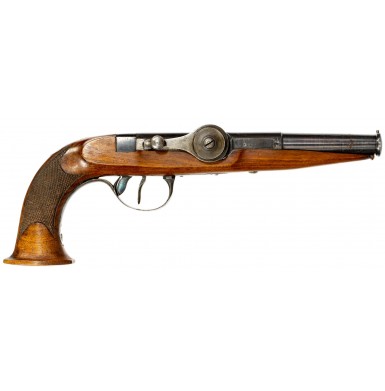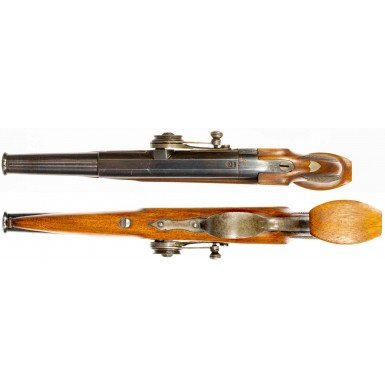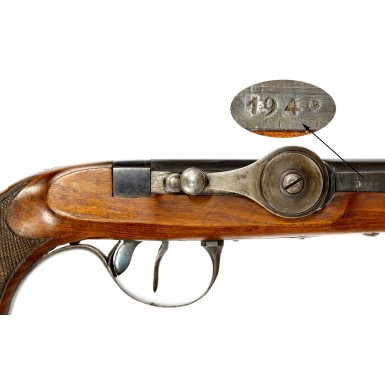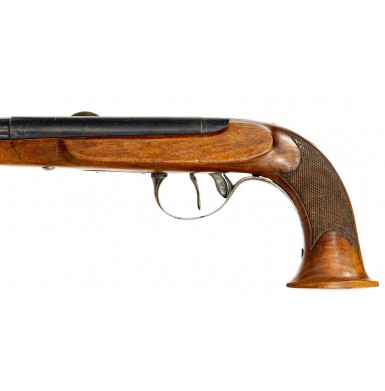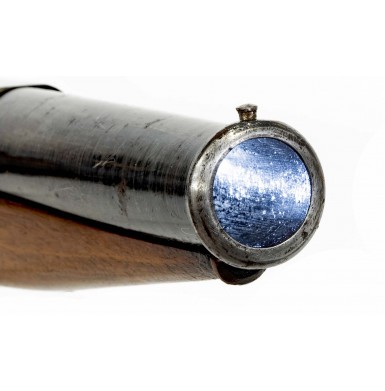Scarce Dreyse & Collenbusch Needle Fire Pistol - Very Fine+
- Product Code: FHG-2257-SOLD
- Availability: Out Of Stock
-
$1.00
Johann Nikolaus Dreyse (later Nikolaus von Dreyse) was born in Sömmerda, a town in the German state of Thuringia in 1787. The son of a lock maker, Johann Nikolaus Dreyse was apparently mechanically inclined and was apprenticed in his father’s shop at the age of 14. Within a few years he showed promise as a gunsmith and around 1805 he headed off to seek additional training by working in the gunmaking region of Leipzig, Saxony. By the age of 22 Dreyse was working in Paris for the famous Swiss gunsmith and firearms designer Jean-Samuel Pauly. Dreyse worked for Pauly from 1809 to 1814 and was in Pauly’s employ while the Swiss inventor worked on a design for a practical breechloading military rifle that utilized a self-contained cartridge. Pauly had developed the formula for fulminate of mercury, a primary explosive agent that would become the basis for percussion cap and self-contained cartridge ignition. In 1808, while working with French gun maker François Prélate, Pauly developed the first self-contained cartridges, utilizing a potassium chlorate primer powder, a fulminate of mercury ignition system, and a bullet, all contained in a casing of either brass or paper. The ignition contact was made by the first successful modern “firing pin”, which was a long needle that penetrated the cartridge and ignited the priming compound at the base of the bullet. With this invention, the world had been introduced to both the self-contained cartridge and the needle fire system.
On April 5, 1814 the Allied forces lead by Great Britain took Paris and with Napoleon’s abdication six days later the era of the First Empire in France came to a close. With the fall of Paris, Pauly escaped to London, where he continued to work on firearms designs, primarily in association with the London gunmaker Durs Egg. Dreyse returned to Sömmerda where Pauly’s influence clearly directed his thoughts and designs. In 1824, Dreyse opened a factory in Sömmerda to manufacture percussion caps, based upon Pauly’s formula for fulminate of mercury. He partnered with Carl Collenbusch in this endeavor and the firm of Dreyse & Collenbusch was born. In addition to making percussion caps, Dreyse & Collenbusch also manufactured ammunition and Dreyse continued to try to improve upon Pauly’s needle fire concept. In 1824 he introduced a muzzleloading needle fire pistol and in 1827 a muzzleloading rifle of the same basic design, which he subsequently produced as a faucet breech breechloader. In 1836, he introduced the genesis of a new breechloading rifle. The new design was a bolt action, breechloader, that relied upon the Pauly inspired needle fire firing pin to pierce the self-contained paper cartridge and ignite the “percussion cap” at the base of the bullet, using the bullet as the anvil upon which the primer was struck. The fact that the rifle was a bolt operated breechloader offered significant advantages over the conventional muzzleloading arms of the day. It allowed a much greater rate of fire than a muzzleloader and allowed the user to easily load the gun while prone or in other positions that were not conducive to the use of a muzzleloading long arm. The Prussian military saw the great potential of such a weapon, particularly when used against an opponent with conventional muzzleloader. With the help of the Prussian state’s funding, the partners of Dreyse & Collenbusch built their first large firearms factory during 1840-1841. Now that the firm could produce arms in quantity the real potential of the needle fire breechloading military rifle could be realize. In 1841, Prussia adopted Dreyse’s design as the Leichtes Perscussions-Gewehr Model 1841 (Light Percussion Rifle Model 1841), a name chosen to help conceal the radical technology of the design. Eventually the secret was revealed to the world and a variety of Prussian Zündnadelgewehr (needle-gun) models would be utilized by the Prussian military for some three decades until the adoption of the Mauser M1871 rifle.
While the bolt action Dreyse design certainly had its military advantages, it had some technological disadvantages as well. The action of the rifle did not offer any form of obturation (gas seal) other than the cartridge itself, so the action leaked gas when it was fired, and this also reduced the velocity and overall effective range of the bullet. The ignition design also meant that the long needle-like firing pin was inside the cartridge when it detonated, causing the corrosive fulminate of mercury priming compound and the hot gasses from the exploding cartridge to corrode and weaken the needle, eventually causing it to break after an average of about two dozen rounds had been fired. Despite these disadvantages, the rapid rate of fire of the guns in the hands of the well trained Prussian troops allowed the Dreyse design to dominate European battlefields for more than two decades.
With the adoption of the M1841, Dreyse expanded his Sömmerda factory to produce needle rifles for military service as well as a line civilian needle rifles and handguns. Initially the handguns were single shot affairs based upon the design introduced circa 1824, but sometime around 1860 Dreyse introduced a needle fire revolver to his product line. The design had been patented by George L. Kufahl in Great Britain on March 3, 1852 (British Patent #13994, 1852), but had not been well received and no British makers seemed inclined to produce a revolver based upon Kufahl’s design. Kufahl’s patent would only be in effect for fourteen years (expiring on March 3, 1866), so it appears that he approached Dreyse sometime around 1860 to produce his revolver design under license in order to monetize his invention. The Dreyse manufactory in Sömmerda would eventually produce between 11,000 and 12,000 of these unique, needle fire revolvers over the course of about two decades. The estimated production numbers are based upon known surviving examples serial numbered in the low 11,XXX range. The guns appear to have been produced in three basic models, all essentially identical in action and design and varying only in overall size and caliber. All of the guns were self-cocking revolvers with needle fire ignition systems. Today, we would refer to these guns as having double action only lock works and being striker fired. The guns were available in three basic bore sizes, much like most percussion revolvers of the period being offered in “pocket”, “belt” and “holster” models. The revolvers were offered in approximately .30 caliber with a 3 ¼” barrel, in .38 caliber with a 4” barrel and in .43 caliber with a 4 ¾” barrel. I say “approximately” as the caliber of the guns was measured in a Prussian variant of inches, the Zoll (pre-metric system) that is about 8% larger than the English inch. The Zoll varied across the German states, being anywhere from 1/10 to 1/12 of a foot, and the length of a foot varied in the German states as well, being as short as about 9 ¼” in some locations and as long as 17 1/8” in others! Thus, one of these revolvers marked “35 cal” would actually measure about .38”. However modern the Dreyse-Kufahl self-contained cartridge revolver was at the time, the basic mechanical concept had originated with Dreyse’s 1824 muzzleloading, needle fire pistol.
The Dreyse & Collenbusch pistol was a single shot, muzzleloading, smoothbore pistol that used the earliest variant of Dreyse’s needle fire lock work and his self-contained paper cartridge. A large cocking lever was situated on the right side of the pistol which was lifted and pulled to the rear to cock the needle striker. The cocking lever could be left in the rearward position, with the pistol “cocked” but the striker was not free to be released by the trigger. Only when the cocking lever was returned to its original position, pointed towards the muzzle was the gun’s mechanism fully ready to fire. A flat safety that resembles a second trigger is located at the rear of the trigger guard that serves as trigger block. Pushing the lever towards the right side of the gun blocks the trigger’s rearward travel, while pushing it to the left moves it so the trigger can be pulled to fire the gun.
The pistol was roughly 12 ¼” in overall length and had a nominally 9” round, two-stage barrel with the larger rear section having a flat on top and measuring roughly 4 5/8” in length. The front section of the barrel tapered dramatically and terminated in a swelled canon shaped muzzle bell with a baluster turned ring. The smooth bore was nominally .56 caliber or about 14mm. The one-piece walnut stock took its inspiration from French Empire officer’s and target pistols with a wide, flat butt and checkered grip. Like the front section of the barrel, the forend tapers and narrows radically, terminating in a tiny semi-Schnabel tip that is roughly ¼ the width of the majority of the stock. The mountings consisted only of a simple iron triggerguard. The pistol’s finish typically consisted of blued barrels with color casehardened cocking mechanisms, triggers and triggerguards. The safety was normally fire or nitre blued to a brilliant sheen. Markings were minimal with the breech marked with a Prussian and D&C cartouche, along with a serial number. The barrel was also serial numbered on the right side, only visible when the cocking lever was in the rearward position. Production numbers are not known, but it is unlikely that more than a couple thousand were produced, with less than a thousand somewhat more likely. While the pistol was never officially adopted by the Prussian military it is almost certain that some were acquired by Prussian officers for personal use, and some of these guns more than likely provided many young officers with their first experience with Dreyse’s designs that would revolutionize Prussian military in a little less than two decades.
Offered here is a VERY FINE to NEAR EXCELLENT condition Dreyse & Collenbusch Needle Fire Pistol. As is typical the gun is sparsely marked. The breech is deeply stamped with a {Prussian Eagle} cartouche, an equally deep D&C Dreyse & Collenbusch cartouche and with the serial number 194. The matching serial number is found on the right side of the barrel, concealed by the cocking lever when it is in the forward position. A small German silver shield shaped thumb plate escutcheon is set into the upper rear of the grip. The gun retains the large majority of its original blued finish on the barrel, with only minute traces of case color on the cocking mechanism and triggerguard. The barrel and breech retain more than 90% of their original blued coverage, with some thinning and fading. The breech areas has developed a slightly plum color, likely due to the heat of firing the pistol. The barrel also shows some minor loss due to handling and use, some wear along the high edges and contact points and a few minor finish scratches. The metal is almost entirely smooth, with some scattered flecks of surface oxidation and a few tiny patches of minor surface roughness which is mostly confined to the circumference of the barrel about 1” from the muzzle. The cocking lever and triggerguard only retain some minute hints of the mottled case color and have a mostly smoky gray appearance with some wavy darker gray and blue tones and some flecks of brownish oxidation here and there. The trigger retains slightly more traces of case color with some mottled color visible near the top of the trigger. The safety retains most of its brilliant nitre-blued finish. The action of the pistol functions perfectly and the cocking and firing mechanism works exactly as it should. The needle remains in place and appears to be full length. The safety mechanism functions correctly, but appears to be slightly worn, as stiff pressure on the trigger can allow the trigger to move past the block when the safety is engaged. The bore of the pistol is moderately oxidized with some surface rust and crust that could probably be carefully cleaned, as long as the mechanism is cocked, and the needle is retracted into the action, so the cleaning does not break it. The stock of the pistol VERY FINE to NEAR EXCELLENT condition as well and remains extremely crisp. The stock is full-length and free of any breaks, cracks or repairs. The checkered grip remains fine and crisp with the checkering remaining extremely crisp. The wood does show some very minor light handling marks and minor marks but remains extremely crisp overall.
Overall this is a really wonderful example of a very scarce, very early production Prussian “cartridge” pistol designed and produced by the famous Nikolaus von Dreyse. This was Dreyse’s first “production” firearm that was produced in any significant numbers and brought his innovative design to attention of the Prussian military. For any collector of needle fire Dreyse weapons this is a “must have” as the first of his real commercial models. It also fits in any collection of Prussian handguns, as the first “cartridge” handgun in a German pistol collection and as a fine example of an early and innovative firearm design. These guns do not appear on the market very often and this is a really exceptional example. I am quite sure you will be extremely happy with this pistol when you receive it and add it to your collection.
SOLD
Tags: Scarce, Dreyse, &, Collenbusch, Needle, Fire, Pistol, Very, Fine+


